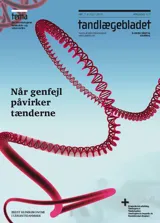Amelogenesis imperfecta: Gener, proteiner og fænotyper
Introduktion – Traditionelt bliver amelogenesis imperfecta (AI) identificeret og klassificeret vha. emaljens kliniske udseende. Emaljen kan være misfarvet, blød og hypoplastisk af varierende grad samt udvise radiologisk forandring, ofte med nedsat røntgenkontrast. Nyere forskning muliggør inddeling af amelogenesis imperfecta på baggrund af genetiske fejl, hvilket bidrager til større forståelse af emaljeproteinernes funktion under amelogenesen samt sygdommens patogenese. Formål – Denne artikel gennemgår gener og proteiner, hvor fejlkodning er kendt eller mistænkt for at deltage i AI-patogenesen. Proteinernes generelle funktioner bliver angivet kort i det omfang, de er kendte. Materiale og metode – PubMed blev søgt uden sproglige restriktioner indtil 2012. Søgeord: amelogenesis imperfecta, amelogenesis, amelogenin, ameloblastin, amelin, sheathlin, enamelin, tuftelin, dentin sialophosphoprotein, dentin sialoprotein, dentin glycoprotein, dentin phosphoprotein, dentin matrix protein-1, enamelysin, kallikrein-4, dlx3 og kombinationer af disse. Resultater – En række proteiner med vidt forskellig funktion ses involveret i amelogenesen. Den umodne emalje består af amelogeniner og non-amelogeniner. Hvis der er fejl i dannelse eller funktion af et eller flere af disse proteiner, vil det kliniske billede på sygdommen ofte afspejle, hvor i amelogenesens forløb fejlen opstår, og proteinets funktion betinger graden og karakteren af emaljemisdannelse. Konklusion – Det tidspunkt af amelogenesen, der bliver forstyrret – altså den periode af emaljedannelsen, hvor en AI-gen- og proteinfejl fremtræder – afspejler sig direkte i den kliniske AI-fænotype med enten hypoplastisk, hypomineraliseret eller umoden emalje. Blandede AIfænotyper kan forekomme.
Amelogenesis imperfecta: Genes, proteins, and phenotypes
Introduction – Traditionally, amelogenesis imperfecta (AI) is identified and classified based on changes in the clinical appearance of the enamel. The enamel may be discolored, soft and hypoplastic to varying degrees, and exhibit radiological changes often with reduced X-ray contrast. Recent research enables classification of amelogenesis imperfecta on the basis of genetic defects, which contributes to a better understanding of both the enamel protein function during amelogenesis, and the pathogenesis of the disease. Objective – This article reviews genes and proteins, in which error coding is known or suspected to participate in the AI pathogenesis. The general protein functions are listed briefly to the extent that they are known.
Materials and method – PubMed was searched without language restrictions until 2012. Keywords: amelogenesis imperfecta, amelogenesis, amelogenin, ameloblastin, amelin, sheathlin, enamelin, tuftelin, dentin sialophosphoprotein, dentin sialoprotein, dentin glycoprotein, dentin phosphoprotein, dentin matrix protein- 1, enamelysin, kallikrein-4, dlx3 and combinations of these.
Results – A number of proteins with different function are involved in amelogenesis. The immature enamel contain amelogenins and non-amelogenins. If there are errors in protein formation or function, of one or more of these proteins, the clinical representation of the disease often reflects the stage during amelogenesis where the fault show up. Changes of the protein function determine the degree and nature of the enamel malformation.
Conclusion – The phase of enamel formation where an AI gene and protein error appears and amelogenesis is disturbed – during stages of respectively secretion, mineralization or maturation of enamel matrix – is mirrored directly in the clinical AI phenotypes with either hypoplastic, hypomineralisation, or hypomaturation enamel type. Mixed AI types may appear.


